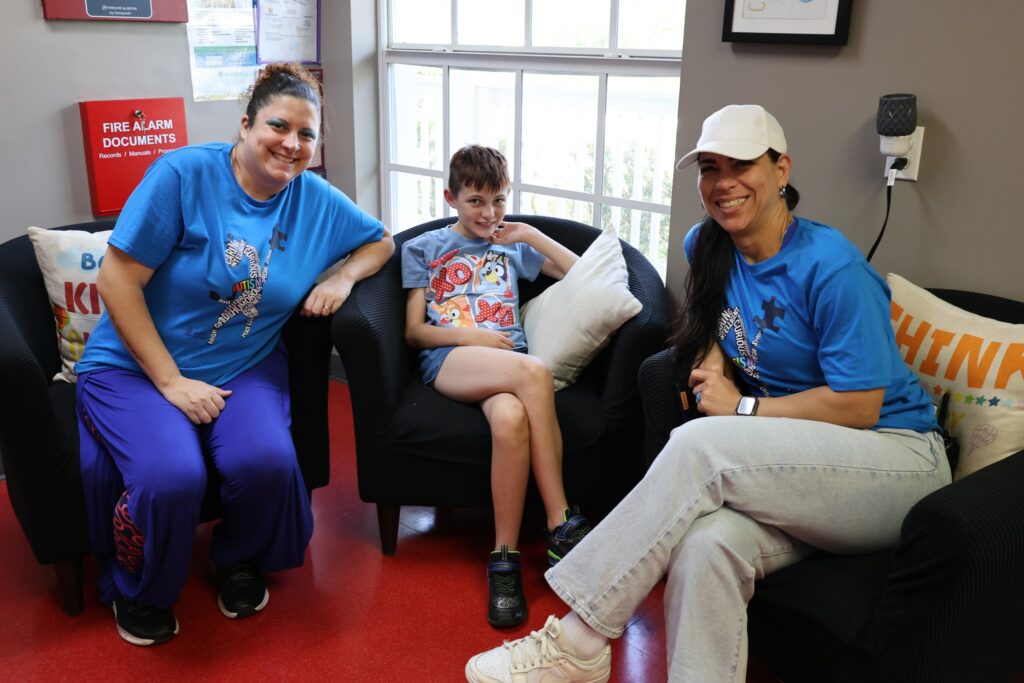Sarah and Mark never anticipated the journey they were about to embark on when their daughter, Alex, was diagnosed with Autism Spectrum Disorder (ASD). It began subtly, with Alex being unusually quiet during social gatherings and fixating on specific toys for hours. As he grew older, his struggles became more apparent.
Simple tasks like making eye contact or understanding sarcasm seemed impossible to him. Sarah and Mark found themselves constantly juggling therapy appointments, school meetings, and advocating for Alex’s needs. The world often felt like a minefield for them, navigating meltdowns in public places and enduring judgmental stares from strangers.
Despite the challenges, their love for Alex never wavered. They celebrated every small victory – an unfamiliar word spoken, a successful interaction with a peer – with tears of joy and pride. Through their journey, Sarah and Mark learned to see the world through Alex’s eyes, embracing his unique perspective and cherishing the moments of connection they shared.
Their experience taught them the importance of patience, empathy, and understanding when raising a child with ASD. They hope that by sharing their story, other parents will realize that while the journey may be challenging, it is also incredibly rewarding. Every child deserves love, acceptance, and support.
In this blog, we will explore autism spectrum disorder, its common symptoms, potential causes, the diagnosis process, available treatment options, and the challenges faced by individuals and their families. By gaining a better understanding of autism, we can work towards creating a more inclusive and supportive world for autistic individuals. Let us dive in!
Within the context of understanding ASD, it is crucial to consider the profound impact a specialized school, like Puzzle Box Academy, can have on a childlike Alex. A specialized school tailored to the needs of children like Alex can be a transformative environment. It offers a supportive and understanding community where Alex can thrive.
In this setting, educators are trained to recognize and address the unique challenges associated with Autism Spectrum Disorder (ASD). They provide individualized learning plans that cater to Alex’s strengths and weaknesses, allowing him to progress at his own pace. The school environment is structured yet nurturing, with sensory-friendly classrooms and strategies in place to help Alex regulate his emotions and behavior.
Social skills training is integrated into the curriculum, fostering meaningful connections with peers and building confidence in social interactions. Additionally, therapy services such as speech and occupational therapy are readily available, ensuring that Alex receives comprehensive support to reach his full potential. Most importantly, a special needs school celebrates Alex for who he is, embracing his differences and empowering him to embrace his strengths.
Understanding Autism Spectrum Disorder
Autism spectrum disorder, often referred to as ASD, is a neurodevelopmental disorder that impacts an individual’s social communication, social interaction, and repetitive behaviors. It is important to note that autism is a spectrum disorder, meaning it presents differently in each person.
Did you Know?
Between 2014 and 2021, the rates of reported autism ranged from 2.3% to 3.7%.
Autism Spectrum Disorder (ASD) typically initiates before the early age of 3 and can persist throughout an individual’s lifetime, albeit symptoms might ameliorate with time. Certain children exhibit ASD indicators before reaching 12 months of age, while in others, these signs may not manifest until 24 months or beyond. Some children diagnosed with ASD exhibit progressive skill development and achieve developmental milestones until approximately 18 to 24 months of age, after which they may either plateau in skill acquisition or experience regression, losing previously attained abilities.
Some kids may have mild symptoms, while others may experience more significant challenges. The spectrum includes conditions such as autistic disorder, childhood disintegrative disorder, and Asperger syndrome.
Mental health problems, such as anxiety and depression, are also commonly associated with autism spectrum disorder. With the increasing prevalence of ASD, early diagnosis and effective disease control strategies are crucial for children and families affected by this disorder.
How Frequently ASD Occurs
Since 2000, the Centers for Disease Control and Prevention’s (CDC) Autism and Developmental Disabilities Monitoring (ADDM) Network has been gauging the prevalence of Autism Spectrum Disorder (ASD) among 8-year-old children in the United States.
ASD manifests across all racial, ethnic, and socioeconomic demographics, with a prevalence exceeding four (4) times higher among boys than girls.
Recognizing the Symptoms of Autism

Recognizing the symptoms of autism is essential for early intervention and support. Challenges in social communication and repetitive behaviors characterize autism spectrum disorder. Let us explore some common characteristics associated with autism and the social communication and interaction behaviors that may be observed in kids with autism.
Interaction and Social Communication behaviors may include:
- Avoids or fails to establish eye contact
- Does not acknowledge or respond to their name by 9 months old
- Lacks facial expressions such as happiness, sadness, anger, or surprise by 9 months old
- Does not engage in simple interactive activities like pat-a-cake by 12 months old
- Displays minimal or no use of gestures by 12 months old (e.g., does not wave goodbye)
- Fails to share interests with others by 15 months old (e.g., does not show objects they like)
- Does not point to indicating interest in something by 18 months old
- Does not demonstrate awareness when others are hurt or upset by 24 months old
- Does not engage with other children in play by 36 months old
- Does not engage in imaginative play, like pretending to be a teacher or superhero, by 48 months old
- Does not participate in singing, dancing, or acting by 60 months old
These social communication and interaction behaviors can vary in severity from kid to kid. Understanding and accommodating these unique communication styles is essential in promoting inclusive environments and supporting autistic individuals’ social interactions.
Restricted and Repetitive Behaviors
Recognizing the symptoms of autism is crucial for early intervention and support. Challenges in social communication and repetitive behaviors characterize autism spectrum disorder. Let us delve into some of the social communication and interaction behaviors associated with autism and the restricted and repetitive behaviors often observed in children with autism.
Some examples of restricted and repetitive behaviors include:
- Special interests or intense focus on specific topics, often beyond typical or age appropriate.
- Repetitive movements or behaviors, such as hand-flapping, spinning, or rocking, provide comfort or stimulation.
- Need for routine and structure, finding comfort and security in predictable schedules and familiar environments.
It is important to recognize that these behaviors serve different purposes for individuals with autism, and they should be respected and understood as a part of their unique perspective and way of engaging with the world.
Other Characteristics
Many individuals with ASD exhibit additional related traits, which could encompass:
- Language skills developing at a slower pace
- Movement skills showing delayed progress
- Cognitive or learning skills exhibiting delays
- Behavior characterized by hyperactivity, impulsivity, and/or inattention
- Presence of epilepsy or seizure disorder
- Unconventional eating and sleeping patterns
- Experiencing gastrointestinal issues such as constipation
- Demonstrating unusual mood or emotional responses
- Coping with anxiety, stress, or excessive worry
- Displaying either a lack of fear or heightened fear responses beyond typical expectations
It is important to recognize that children with ASD may not display all or any of these mentioned behaviors as examples.
Exploring the Causes of Autism

While the precise origins of autism spectrum disorder remain elusive, ongoing research indicates a multifaceted interplay between genetic and environmental influences. Let us explore the intricate web of biological and genetic factors that potentially contribute to the onset of autism.
Biological Factors
Biological factors, such as abnormalities in brain development and connectivity, have been identified in kids with autism spectrum disorder. Certain medical conditions, like tuberous sclerosis or birth defects, may also increase the risk of autism.
Additionally, prenatal exposure to toxins or factors during early childhood may contribute to the development of autism. While these factors provide insights into the potential mechanisms involved, further research is needed to understand the biological complexities of autism spectrum disorder fully.
Genetic Factors
Genetic factors are believed to play a significant role in the development of autism spectrum disorder. Research has shown that kids with autism often have genetic mutations or variations that impact their neurodevelopment.
The highest prevalence of autism was for Black or African American non-Hispanic children (3.8% in 2018-2021), followed by children of “All Other Races/Ethnicities” (3.4%), and White non-Hispanic children (3%). Autism prevalence was lower among Hispanic children (2.8%) and Asian non-Hispanic children (2.5%).
Family history and hereditary patterns can also contribute to the risk of autism. However, it is important to understand that genetics alone cannot fully explain the complexity of autism, as environmental factors may interact with genetic predisposition to influence its development.
Diagnosis Process for Autism

Accurate and timely diagnosis of autism spectrum disorder is essential for accessing appropriate support and interventions. Autism diagnosis involves comprehensively evaluating an individual’s behaviors, developmental milestones, and communication skills.
Criteria for Diagnosis
Diagnosing autism spectrum disorder includes assessing an individual’s social interaction skills, communication abilities, and the presence of repetitive behaviors. Diagnostic criteria are outlined in the Diagnostic and Statistical Manual of Mental Disorders (DSM-5), published by the American Psychiatric Association. https://bit.ly/DiagnosticManual
These criteria help healthcare professionals evaluate whether an individual meets the necessary thresholds for an autism spectrum disorder diagnosis. It is important to consider developmental milestones, as delayed language skills or other developmental factors may indicate a higher risk of autism spectrum disorder in young children.
Treatment Options for Autism
Effective treatment strategies can significantly improve the quality of life for individuals with autism spectrum disorder. While there is no cure for autism, there are various available treatment options that can help manage symptoms and support overall well-being.
Non-pharmacological Interventions
Non-pharmacological interventions, such as behavioral therapy, social skills training, and early intervention services, are critical components of autism treatment. Behavioral therapy focuses on teaching individuals’ new behaviors, reducing challenging behaviors, and improving social interaction skills.
Social skills training helps kids with autism develop appropriate social skills, such as initiating conversations or understanding social cues. Early intervention services, delivered by a multidisciplinary team, aim to address developmental delays, communication deficits, and behaviors associated with autism spectrum disorder.
These interventions, tailored to the unique needs of everyone, can significantly improve their social communication, functional abilities, and overall quality of life.
Pharmacological Interventions
In some cases, pharmacological interventions may be considered as part of an individualized treatment plan for autism spectrum disorder. Medications may be prescribed to manage specific symptoms, such as attention deficit hyperactivity disorder or anxiety, that often co-occur with autism.
However, it is important to note that medications are not a universal intervention for autism, as their effects can vary from child to child. The administration of medication, also known as drug administration, should always be based on a thorough evaluation of an individual’s symptoms, overall health, and potential benefits and risks.
Collaboration between healthcare professionals, individuals, and their families is crucial in determining the most appropriate treatment approach.
Early intervention can change a life.

Early intervention services play a significant role in shaping the lives of kids with autism spectrum disorder. Research has shown that early detection and intervention improve developmental outcomes, social communication skills, and overall quality of life.
The brain’s neuroplasticity during early childhood makes it a crucial period for targeted interventions that can positively impact an autistic child’s learning, social interaction, language skills, and adaptive behaviors.
Investing in early intervention services can make a meaningful difference in the lives of kids with autism spectrum disorder, setting a foundation for their future growth and success.
The importance of early detection and intervention for children with autism
Early detection and intervention are paramount when it comes to autism spectrum disorder. Identifying autism early allows for prompt access to crucial intervention services, providing children with the best opportunity for optimal development and improved outcomes.
Some key reasons why early detection and intervention are important include:
- Targeting developmental milestones: Early intervention focuses on addressing developmental delays, especially in areas such as language and social interaction, targeting specific skills at critical periods of development.
- Promoting social communication skills: Intervention services, such as speech therapy, help children develop language skills, social interaction, and nonverbal communication, enabling them to navigate social situations better.
- Facilitating family involvement: Early intervention services often involve family members, equipping parents and caregivers with strategies to support their child’s development, communication, and overall well-being.
- Maximizing potential: Early intervention capitalizes on the brain’s neuroplasticity, enabling children to make significant gains in cognitive, communication, and adaptive skills, maximizing their potential for independence and success.
Early detection of autism involves monitoring developmental milestones, recognizing early signs of social communication deficits, and seeking professional evaluation if concerns arise. By promoting early intervention, we can provide children with autism spectrum disorder with the support they need to reach their full potential.
Did You Know?
For 2018–2021, the rate of reported autism was about four times higher in boys than in girls, 4.6% and 1.5%, respectively.
Frequently Asked Questions
Is there a known cause of autism?
The exact cause of autism spectrum disorder is still unknown, but research suggests that both genetic and environmental factors contribute to its development. Genetic factors, such as inherited genetic variations or mutations, play a significant role.
Environmental factors, including prenatal exposure to certain toxins, complications during childbirth, and early childhood experiences, may also influence the risk of autism. It is important to note that vaccines do not cause autism, as extensive scientific evidence has disproven any connection.
Are there any effective treatments for autism?
While there is no cure for autism spectrum disorder, there are various intervention strategies and therapeutic approaches available to support individuals with autism. These may include:
- Behavioral therapy aims to teach new skills, reduce challenging behaviors, and improve social interaction abilities.
- Speech therapy: Speech therapy helps individuals develop communication skills, including language, social, and nonverbal communication.
- Occupational therapy: Occupational therapists work with autistic individuals to develop skills necessary for daily living, such as self-care, fine motor skills, and sensory integration.
- Medication: In some cases, medication may be prescribed to manage specific symptoms, such as hyperactivity or anxiety, that often co-occur with autism.
It is vital to remember that every autistic individual is unique, and their treatment plan should be tailored to their specific needs. The intervention aims to enhance the quality of life, promote independence, and support overall well-being in individuals with autism spectrum disorder.
How can I support youngsters with autism in my community?
Helping youths with autism in your community can make a significant difference. Educate yourself on autism and its challenges, support local autism organizations and events, and be patient and understanding in your interactions. Advocate for increased resources and support for youngsters with autism.
Conclusion
In conclusion, autism is a complex spectrum disorder that requires a comprehensive understanding and approach. It is essential to recognize the common characteristics and behaviors associated with autism and the potential causes to provide the best support and treatment options.
Early intervention plays a crucial role in improving outcomes for kids with autism, and it is essential to address any challenges or barriers to accessing these interventions. Living with autism can present unique challenges for both kids and their families, but it is also an opportunity for growth and understanding. Society and culture play a significant role in shaping perceptions of autism, and promoting acceptance and inclusivity is vital.
If you find yourself in a situation like Sarah and Mark, parents navigating the complexities of raising a child with autism, remember that seeking help and support is a courageous step. Enrolling your child at Puzzle Box Academy means offering them the opportunity to receive individualized support and evidence-based interventions that promote growth and success.
Our comprehensive approach focuses on academic achievement, fostering independence, self-confidence, and lifelong skills. Join us in shaping a brighter future for students with autism by enrolling them at Puzzle Box Academy.
Together, we can unlock their full potential and pave the way for a fulfilling and inclusive educational journey.
Schedule a visit or consultation today to learn how Puzzle Box Academy can make a difference in your child’s life.



